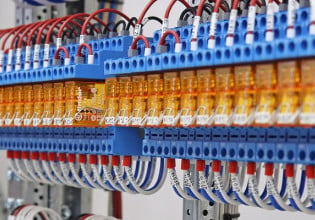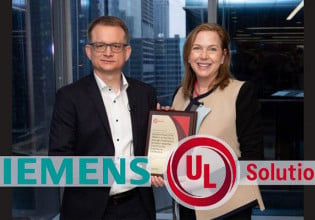NVIDIA Forges Industry Partnerships for Gen AI and Industrial Ops
Following its recent GPU Tech Conference, learn how NVIDIA, the artificial intelligence computing pioneer, is transforming the future of automation through its latest industry partnerships.
Recently, NVIDIA wrapped up its 16th GPU Technology Conference (GTC), with many announcements geared toward the promotion of generative artificial intelligence (AI) and fostering intelligent automation to help realize the age of the industrial metaverse.
As we look back on the GTC, we’ll spotlight partnerships that were announced between NVIDIA and four key industrial players that focus on immersive visualization for digital twin technology, integrating AI and advanced computing for industrial applications (including pallet handling), AI production inspection, and predictive maintenance.

The AI-driven MiR1200 Pallet Jack employs RGBD cameras, 3D LiDAR, and image processing via the NVIDIA Jetson AGX Orin module to navigate its surroundings, avoiding obstructions and unnecessary collisions. Image used courtesy of MiR
Autonomous Pallet Handling
Universal Robots (UR) and Mobile Industrial Robots (MiR) comprise Teradyne Robotics, which revealed two AI-driven solutions for precision pallet handling and autonomous inspection during NVIDIA’s conference. Both solutions integrate NVIDIA Jetson AGX Orin modules. These modules provide as much as 275 TOPS of AI performance and feature a 2048-core NVIDIA Ampere architecture GPU with 64 Tensor Cores.
MiR, specializing in autonomous mobile robot technology, collaborated with NVIDIA to develop its AI-driven pallet handling solution, the MiR1200 Pallet Jack, which runs on the NVIDIA Jetson AGX Orin module. The Jetson platform compiles feedback from four RGBD depth cameras and 3D LiDAR (light detection and ranging) technology to execute 3D object detection and autonomous navigation, ultimately helping to facilitate rapid and precise pallet handling. The MiR1200 is trained on a substantial amount of visual data, as much as 1.2 million images of both real-world and generated scenarios.
The advanced computing from the Jetson platform enables the processing of data in real-time, which allows the MiR1200 Pallet Jack to navigate its surroundings to avoid unnecessary collisions and effectively maneuver itself in tight/limiting spaces, which can help boost the efficiency of logistics operations and ensure pallets are delivered on time.
UR demonstrated its AI-driven inspection solution at NVIDIA’s GTC conference, comprising NVIDIA Isaac Manipulator platform cuMotion’s path planner, NVIDIA Jetson AGX Orin, UR’s PolyScope X software, and UR5e cobot platform. The combination of these technologies is hoped to expand what’s possible in the realm of automated industrial applications.
AI for QA, Safety, and Inspection
NVIDIA is also working alongside an NVIDIA Elite Partner and edge computing company, ADLINK Technology Inc. (ADLINK), to support the deployment of AI-driven inspections and digital twins within ADLINK’s AI Smart Factory solution. The latter company showcased its Smart Factory solution at the GTC.

NVIDIA Omniverse facilitates AI training by simulating product case defects such as scratches serving as a reference for accurately identifying scratches on a real-world product case. Image used courtesy of ADLINK
The solution leverages NVIDIA’s Jetson AGX Orin module to operate its edge AI platform, DLAP-411-Orin. This platform is integral to ADLINK’s AI-powered six-sided product case inspection system, which automates visual inspection (identifying defects in products before shipment. NVIDIA Omniverse simulates defects (such as a scratch on the product casing) to provide a training reference for the successful identification of defects on product casings in a real-world setting.
The NVIDIA Jetson Xavier NX module-powered ADLINK NEON-2000 JNX Series AI Smart Camera is intended to improve the process of examining accessories during product packing by leveraging leading-edge AI-driven visual inspection features. Enhanced inspection means streamlined deployment and improved product quality.
Furthermore, in high-voltage test zones, ADLINK uses the NEON AI Smart Camera with the low/no-code EVA (edge vision analytics) software in its AI Smart Factory. AI recognition algorithms are utilized in this setup to enforce safety regulations, such as ensuring that personnel wear required personal protective equipment, which reduces the possibility of mishaps like electric shocks and fires.
Digital Twin Technology
Rockwell Automation has teamed up with NVIDIA to accelerate the transformation of industrial processes, making way for the "factory of the future." By incorporating sophisticated technologies such as generative AI, advanced sensing, and efficient computing, the cooperation hopes to expedite industrial processes and digitalization initiatives.
The partnership includes combining NVIDIA Omniverse Cloud application programming interfaces (API) with Rockwell's Emulate3D to improve data connectivity and visualization for constructing simulated copies of physical production systems in the form of digital twins. Furthermore, Rockwell's work on the NVIDIA robotics platform for edge AI aims to alleviate worker shortages while also improving logistics and production efficiency through sophisticated automation applications. This partnership emphasizes AI's role as an essential engine of the Smart Factory of the future with key impact areas including design and production agility, as well as sustainability.
Siemens and Omniverse Cloud
Siemens envisages an industrial metaverse where its customers can interact with digital copies of products and production environments using natural language input. At the NVIDIA GTC, Siemens and NVIDIA highlighted how generative AI can revolutionize data visualization, enabling photorealism, and how HD Hyundai, a sustainable shipbuilder, can use it to create new products.
Siemens will leverage new NVIDIA Omniverse Cloud APIs to establish comprehensive visualization of industrial processes and promote the use of digital twin technology.
The Siemens Xcelerator portfolio will leverage generative AI, advanced computing, and NVIDIA Omniverse to make the industrial metaverse a reality. Video used courtesy of Siemens
Siemens and NVIDIA are developing a new solution for Teamcenter X, Siemens' cloud-based Product Lifecycle Management (PLM) software, which will be released later this year. This service, based on NVIDIA Omniverse technology, allows teams of engineers to develop visually realistic, real-time digital twins with a solid grounding in physics. Generative AI will enable more rapid digital twin development, saving time and allowing engineering teams to collaborate together to refine and execute designs.






